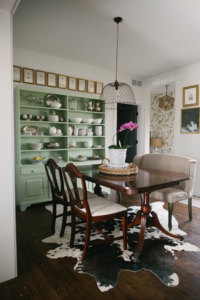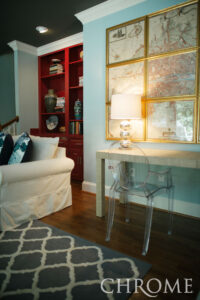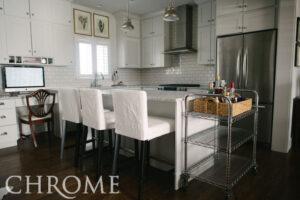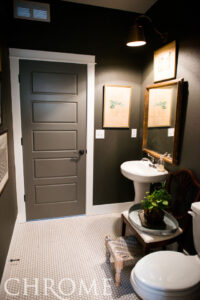Article by
Johi Kokjohn-Wagner
Photography by
Jennifer Little, Sugar Photography
Color is a critical element of interior design, and there are many different approaches to the application of pigmentation. Color choices range from bold to conservative. Hues can be implemented sparingly or wildly. Finding a successful color story for your interior that is pleasing to all who dwell there can feel complex. However, with a few simple guidelines, you can take the guesswork out of creating a cohesive palette. Jade O’Connor, lead interior designer of
Jade O’Connor Designs, Inc., offers chromatic consultation to aid in creating a beautiful color scheme for your home.
1. Locate your color inspiration.
Many resources can influence color selections for your home. Ideas can be gathered from regional landscapes and the rules of the color wheel, as well as from historical architecture, paintings and your personal wardrobe.
“There is a natural color palette waiting for you that you are inherently drawn to. Go with your instincts,” Jade said.

Embrace the culture in which you live without being themed. Pulling colors from your regional landscape will translate honestly into your interior.
“Palm Beach does not work well in Arizona,” she pointed out.
Another great source of inspiration is Pinterest. Pin images that you are drawn to and discover your favorite color combinations.
Your closet also contains a lot of insight into your taste in tincture. Why not surround yourself in colors that complement you?
“If you wouldn’t wear it, maybe it shouldn’t be in your home,” Jade said.
2. Discover your palette.

The colors of your home should present themselves as a complete story. If you were to paint a canvas with every color in your home, the hues should all blend and complement each other. For example, the pastel shades of spring, the bright hues of summer, the warm tones of autumn and the crisp, clean whites, grays and blues of winter are all perfectly unified palettes. Select grounding colors to anchor your space; grounding colors include shades of gray, brown, linen, white, black and blue.
“Pick a base color palette for your public spaces: your dining room, hallway, living room and kitchen. You can get a little more personal in your private spaces, like your bedrooms. Select a shade that works with your base color, but feels more intimate,” Jade recommended.
3. Understand what a hue can do.
Colors evoke emotional responses. Color adds depth. Color calms or excites. While blues and greens sooth and relax, reds and oranges bring energy to a room. Design your spaces with their purpose in mind. Analogous (shades of the same hue) color palettes will bring cohesion to a home, and complimentary (across the color wheel) color schemes will create harmonious interest. Monochromatic (black, grey and white) palettes are a no-fail background for all colors.

“Have white, black and blue in every room,” Jade said. “White adds modern appeal; it is fresh and reflective. Black is masculine and dramatic. Every color works with blue.”
Many people fear dark color in their homes, yet Jade praises dark hues.

“When there is no element of architecture in the room, adding a dark color can create drama and give a sense of design,” she said. “Dark paint in a very big space can be magic. A too-big room can become cozier with a deep hue, but it can also make a small space feel bigger because, with the right plan, it becomes seamless.”Jade is mindful of ceilings as well.
“People forget about their ceilings when they decide to paint. My rule for ceilings is this: If I want a room to be encompassed in one color, I mix 30 percent of the wall color with 70 percent white paint. However, if I want the room to feel cozy and enclosed—like a media room—I paint the walls, trim and ceiling all the same color.”
Select colors that elicit positive feelings.
“Surround yourself with happy,” Jane suggested.
4. Work with what you have.

Most people’s home design centers around the common theme of financial reality. To add new hues in a home full of existing color can present some challenges, but fresh paint, new fabric and a specific objective can change the feel of an entire space.“If you have a house full of brown, go bright,” Jade said. “Find a colorful pattern, and pull out a solid.
“For paint, don’t always think you have to choose one color for a room. You can have a focal wall. Application can change everything.”
5. Use the no-fail rule.
Successful use of color is all about a mindful approach. If you are still confused by color, simply apply the 60/30/10 rule.

60% of a room: the walls and floor—the dominant color
30% of a room: the upholstery—a neutral color
10% of a room: the accents—a pop of pizazz.
Our worlds are filled with a variety of color to influence our interiors. Thoughtful and meaningful choices can create a world of personal contentment and beauty within your walls. Your home should be a reflection of you. In short, the hardest part of design is most likely going to be convincing your spouse that you are the one with better taste.
Next Up: Using Pattern & Texture



 Embrace the culture in which you live without being themed. Pulling colors from your regional landscape will translate honestly into your interior.
Embrace the culture in which you live without being themed. Pulling colors from your regional landscape will translate honestly into your interior.

 “When there is no element of architecture in the room, adding a dark color can create drama and give a sense of design,” she said. “Dark paint in a very big space can be magic. A too-big room can become cozier with a deep hue, but it can also make a small space feel bigger because, with the right plan, it becomes seamless.”Jade is mindful of ceilings as well.
“When there is no element of architecture in the room, adding a dark color can create drama and give a sense of design,” she said. “Dark paint in a very big space can be magic. A too-big room can become cozier with a deep hue, but it can also make a small space feel bigger because, with the right plan, it becomes seamless.”Jade is mindful of ceilings as well. Most people’s home design centers around the common theme of financial reality. To add new hues in a home full of existing color can present some challenges, but fresh paint, new fabric and a specific objective can change the feel of an entire space.“If you have a house full of brown, go bright,” Jade said. “Find a colorful pattern, and pull out a solid.
Most people’s home design centers around the common theme of financial reality. To add new hues in a home full of existing color can present some challenges, but fresh paint, new fabric and a specific objective can change the feel of an entire space.“If you have a house full of brown, go bright,” Jade said. “Find a colorful pattern, and pull out a solid.